Place vertices on the plane using the GEM force-directed layout algorithm.
Arguments
- graph
The input graph. Edge directions are ignored.
- coords
If not
NULL, then the starting coordinates should be given here, in a two or three column matrix, depending on thedimargument.- maxiter
The maximum number of iterations to perform. Updating a single vertex counts as an iteration. A reasonable default is 40 * n * n, where n is the number of vertices. The original paper suggests 4 * n * n, but this usually only works if the other parameters are set up carefully.
- temp.max
The maximum allowed local temperature. A reasonable default is the number of vertices.
- temp.min
The global temperature at which the algorithm terminates (even before reaching
maxiteriterations). A reasonable default is 1/10.- temp.init
Initial local temperature of all vertices. A reasonable default is the square root of the number of vertices.
- ...
Passed to
layout_with_gem().
References
Arne Frick, Andreas Ludwig, Heiko Mehldau: A Fast Adaptive Layout Algorithm for Undirected Graphs, Proc. Graph Drawing 1994, LNCS 894, pp. 388-403, 1995.
See also
layout_with_fr(),
plot.igraph(), tkplot()
Other graph layouts:
add_layout_(),
component_wise(),
layout_(),
layout_as_bipartite(),
layout_as_star(),
layout_as_tree(),
layout_in_circle(),
layout_nicely(),
layout_on_grid(),
layout_on_sphere(),
layout_randomly(),
layout_with_dh(),
layout_with_fr(),
layout_with_graphopt(),
layout_with_kk(),
layout_with_lgl(),
layout_with_mds(),
layout_with_sugiyama(),
merge_coords(),
norm_coords(),
normalize()
Author
Gabor Csardi csardi.gabor@gmail.com

